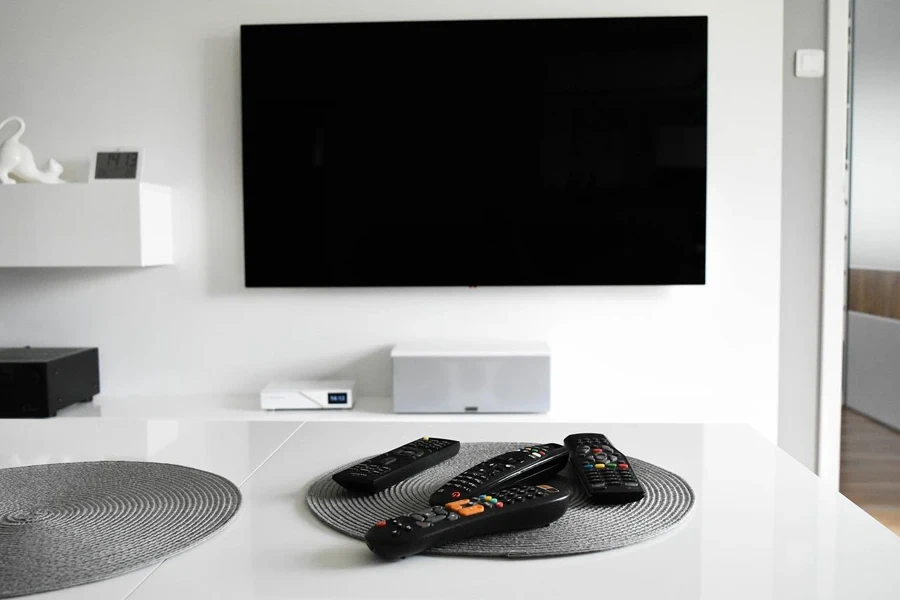OLED TVs are becoming increasingly popular in the home entertainment sector because their picture quality and flexible design options raise the bar for industry standards. The integration of AI and advancements in display technologies are not just improving the viewing experience but also fueling notable growth in the market. As demand grows for quality and energy-efficient displays, understanding the market trends and top models is essential for buyers. This article explores the advancements and popular OLED models influencing market trends. It offers information to help make informed buying decisions that are strategically important for staying competitive in the ever-changing world of electronics.
Table of Contents
● The OLED market: Scale, growth, and shifting trends
● Breaking barriers: Innovations driving OLED technology
● Game-changers: Top OLED models shaping the market
● Conclusion
The OLED market: Scale, growth, and shifting trends

Global OLED market expansion and forecast
The global OLED market is expanding rapidly; analysts predict it will increase from USD 56 billion in 2024 to around USD 345 billion by 2034, based on research by Precedence Research Firm. A growth rate of 19.85% is fueling this growth. The Asia Pacific region leads the way in this market due to the huge manufacturing presence in countries like China and South Korea, where companies like Samsung and LG invest in OLED technology production. The leaders in the area will likely maintain their position as the need for cutting-edge display technologies grows in the consumer electronics industry.
Regional influences and market dynamics
The dominance of the Asian Pacific region’s market is mainly due to its robust electronics manufacturing setup and the presence of top display companies. In 2023, this region held the largest share of the market, with its expansion being driven by increased investments in OLED technology and growing production capabilities. North America is also projected to experience growth due to the growing use of technology in smart TVs, smartphones, and wearable gadgets. The region’s focus on technology and increased consumer purchasing ability play a big role in its fast-growing market expansion and establish it as a major player in the worldwide OLED market scene.
Key market drivers and challenges
The market’s growth is fueled by factors such as energy efficiency and top-notch display quality, which are the key drivers behind its popularity. One of the advantages of this technology is its ability to provide better contrast ratios and faster response times while consuming less power compared to older display technologies. Despite its appeal in high-end consumer electronics due to these benefits, the OLED market encounters hurdles like high production costs and limited reach in some regions due to these pricing challenges. Despite these obstacles, improvements in how things are made and growing economies of size are likely to lower manufacturing expenses, thus making the technology more widely available and accepted by many.
Breaking barriers: Innovations driving OLED technology

AI-powered enhancements and smart integration
AI is dramatically advancing OLED TV technology, enhancing every aspect of the viewing experience through intelligent processing and adaptive features. The latest AI processors in OLED TVs, such as LG’s α (Alpha) 11 AI Processor, boast 4-fold higher AI performance, which optimizes pixel-level image analysis. This leads to sharper images, dynamic tone mapping, and more accurate color reproduction by adjusting millions of pixels in real-time. Samsung’s latest NQ8 AI Generation 3 processor, found in their Neo QLED TVs, integrates 512 neural networks to adjust contrast and clarity while optimizing sound to match the content and viewing conditions accurately. This advanced technology enables the TV to upscale lower-resolution content to near 8k quality using AI algorithms for an immersive viewing experience across all content sources.
Advances in display technology: From QD-OLED to glare-free screens
OLED televisions have been making advancements in screen technology with the emergence of Quantum Dot OLED (QDOLED) panels and anti-glare features. The fusion of quantum dots’ exceptional color accuracy and brightness, with OLED contrast capabilities in QDOLED panels, has led to displays that can achieve brightness levels surpassing 1,800 nits in peak HDR modes. This enables more vibrant colors and enhanced details in dark and well-lit scenes, significantly enhancing the overall visual quality. In settings where lighting cannot be controlled, glare techniques, like microlens arrays and special coating layers, have been created to reduce reflections and ensure colors and brightness remain true without being affected by surrounding light sources.
Wireless and flexible OLED designs

The evolution of OLED design is also taking a leap forward with the introduction of wireless and flexible OLED TVs. LG’s latest OLED models, such as the SIGNATURE OLED M4, are pioneering wireless technology by eliminating all physical connections to the display itself. The Zero Connect Box transmits video and audio signals wirelessly with 4K resolution at 144Hz, allowing for a cleaner installation and reducing cable clutter. In addition to wireless capabilities, flexible OLED designs are gaining traction. Foldable and rollable OLED displays leverage ultra-thin, bendable screens, made possible by advances in organic material and substrate technologies. These designs allow the screen to fold into compact forms or roll out of sight when not in use, providing flexibility in both usage and storage while also pushing the boundaries of interior design integration.
Enhanced durability and performance with material innovations
Material science is playing a critical role in the advancement of OLED TVs, particularly in enhancing durability and performance. The introduction of new organic compounds has significantly improved the lifespan and efficiency of OLED panels, allowing them to maintain brightness and color accuracy over extended periods. Metal-backed substrates and flexible encapsulation layers are being utilized to increase the robustness of flexible OLEDs, making them resistant to physical stress while maintaining their thin and lightweight form factor. These innovations not only extend the functional life of OLED displays but also support the development of larger, more versatile panels without compromising on picture quality. This progress in materials is essential for sustaining the competitive edge of OLED technology in an increasingly demanding market.
Game-changers: Top OLED models shaping the market

Samsung S90C: Redefining value in OLED
The Samsung S90C is known for striking a balance between performance and affordability, making it a top choice for those who want quality without breaking the bank. This model uses Quantum Dot OLED (or QD-OLED), increasing brightness and color accuracy up to 1,100 nits in HDR mode. Moreover, the S90c shines in gaming, producing 4k at 144Hz across all HDMI 2.1 ports. It also boasts features like Variable Refresh Rate (VRR) and Auto Low Latency Mode (ALLN). The S90V guarantees top gaming performance with less delay, in controls at only 9.2 milliseconds measured precisely. Moreover, the Object Tracking Sound technology enhances the quality by adapting sound based on what’s happening on screen, which cements the S90C as the top OLED TV choice for 2024.
LG B3: The budget-friendly OLED that delivers
The LG B3 provides a choice for shoppers seeking quality OLED capabilities at a reasonable cost. This entry-level model offers 4k resolution with HDR features that showcase the colors and deep blacks typical of OLED displays. Its ability to handle 4k at 120Hz and VRR and ALLM support makes it an attractive option for budget gamers. Even though it doesn’t shine as brightly as expensive models, with a peak brightness of approximately 650 nits, the B3 series still delivers outstanding picture quality, especially in dimly lit settings. Its affordability and performance have made it a top pick for most buyers who seek top-notch quality without breaking the bank.
LG G3: The perfect blend of style and substance
The LG G3 stands out for its innovative design and advanced technology that appeals to those who value aesthetics when buying a device. Among its characteristics is the wall mount, with zero gaps that enable the TV to fit perfectly against the wall for a stylish appearance. Moreover, the G3 features Micro Lens Array (MLA) technology that boosts brightness to more than 1,400 nits while enhancing viewing angles without compromising picture quality. The G3 comes with an LG α10 Gen 7 AI Processor for improved upscaling and instant fine-tuning of audio and visuals to offer a notch viewing experience for users seeking a TV that blends cutting-edge technology with elegant design aesthetics.
Samsung S95D: The premium choice for elite experiences
The Samsung S95D delivers exceptional brightness levels, cutting-edge anti-glare technology, and unique gaming capabilities for individuals searching for OLED performance on the market today. With a peak brightness reaching up to 1,868 nits, the QLED panel of the S95 stands out as one of the current OLED TVs. Additionally, this model includes OLED Glare Free reduction technology, which effectively minimizes reflections and preserves picture quality in lit settings. People who love gaming will find the 4k resolution, at 144Hz support very appealing, along with features like VRR (Variable Refresh Rate), ALLN (Auto Low Latency Mode), and Game Bar for easy access settings. The S95D model is made for those seeking top-notch performance and exceptional visual quality as it stands out as a tier TV option.
Sony A80L: The audiophile’s OLED choice
The Sony A80L stands out for its exceptional audio performance that caters to audiophiles and sound enthusiasts alike. This model incorporates Acoustic Surface Audio+ technology, where the display functions as a speaker to deliver sound perfectly synchronized with on-screen content. Moreover, the A80L boasts support for Dolby Vision and HDR10, emphasizing color rendering and deep black levels. Its peak brightness falls short compared to other models in its class, making it better suited for dimly lit viewing environments. This device has exceptional sound and precise visual output, positioning it as the ideal pick for individuals who appreciate a seamless audiovisual experience without additional speakers or systems.
LG C4: The versatile OLED for all spaces
LG C4 maintains LGs tradition of providing top-performing OLED TVs that appeal to an wide range of audiences. It comes in various size options ranging from 42 to 83 inches. The C4 series features LG’s latest α9 Gen 7 AI Processor that boosts brightness and color precision to achieve a peak brightness exceeding 1,000 nits. With Dolby Vision HDR10 and HLG support, it is ideal for content genres such as films and gaming. The C4’s impressive 144Hz refresh rate and wide range of gaming capabilities, like NVIDIA G SYNC and AMD FreeSync, have positioned it as an option among gamers who value performance and versatility across various screen sizes in the OLED sector.
Conclusion

OLED technology is revolutionizing home entertainment by introducing advancements in AI-driven improvements and advanced display technologies with designs that are setting standards in the industry. Leading models such as the Samsung S90C and LG G3 showcase how innovative features contribute to performance and value at various price ranges. With developments in this technology field, OLED TVs are expected to continue leading the market for high-quality displays, making strides toward growth and providing more immersive viewing experiences for audiences globally.




